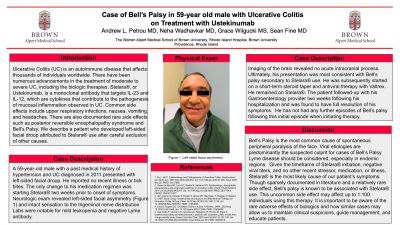Sunday Poster Session
Category: IBD
P1014 - A Rare Case of Bell’s Palsy in a Patient With Ulcerative Colitis on Stelara
Sunday, October 27, 2024
3:30 PM - 7:00 PM ET
Location: Exhibit Hall E

Has Audio

Andrew L. Petrou, MD
Rhode Island Hospital, Brown University Medical School
Providence, RI
Presenting Author(s)
Andrew Petrou, MD1, Grace Wilgucki, MS2, Neha Wadhavkar, MD1, Sean Fine, MD, FACG1
1Rhode Island Hospital, Brown University Medical School, Providence, RI; 2PCOM, Philadelphia, PA
Introduction: Ulcerative colitis (UC) is an autoimmune disease that affects individuals worldwide. There have been many advancements in treatments, including biologics to treat moderate to severe UC. Stelara®, or Ustekinumab, works by targeting specific proteins that contribute to lasting inflammation via cytokine-mediated signaling pathways. Common side effects include upper respiratory infections, nausea, vomiting, and headaches. Though the drug is overall well-tolerated, there are few rare side effects, including posterior reversible encephalopathy syndrome and Bell’s palsy. We describe a patient who developed left-sided facial droop attributed to Stelara® use.
Case Description/Methods: A 59-year-old male with a past medical history of hypertension and UC since 2011, on treatment with Stelara® initiated less than one month prior, presented with left-sided facial droop. He reported no recent illness or tick bites, and his only new medication was Stelara®. Neurologic exam demonstrated left-sided facial asymmetry (Figure 1), and trigeminal cranial nerve distribution (V1 to V3) with intact sensation. Labs were notable for a mild leukopenia and negative Lyme antibody. Imaging of the brain revealed no acute intracranial process. Ultimately, his presentation was most consistent with Bell’s palsy. He was continued on Stelara® and promptly started on a short-term steroid taper and antiviral therapy with Valtrex. The patient followed-up with his Gastroenterologist two weeks after hospitalization and was found to have complete resolution of his facial asymmetry.
Discussion: Bell’s palsy is the most common cause of spontaneous peripheral paralysis of the face. Viral etiologies are most often suspected in cases of Bell’s palsy; however, Lyme disease should be considered, especially in endemic regions. Our patient previously tolerated other treatments for UC, including sulfasalazine and mesalamine, but was started on Stelara® two weeks prior to presentation. Though sparsely documented in literature, this drug has been associated with instances of Bell's palsy. Given the timeframe of Stelara® initiation, negative viral titers, and no other recent stressor, medication, or illness, Stelara® is the most likely cause. Here we demonstrate the importance of understanding adverse effects of biologics and how similar cases may allow us to maintain appropriate clinical suspicion and guide management.

Disclosures:
Andrew Petrou, MD1, Grace Wilgucki, MS2, Neha Wadhavkar, MD1, Sean Fine, MD, FACG1. P1014 - A Rare Case of Bell’s Palsy in a Patient With Ulcerative Colitis on Stelara, ACG 2024 Annual Scientific Meeting Abstracts. Philadelphia, PA: American College of Gastroenterology.
1Rhode Island Hospital, Brown University Medical School, Providence, RI; 2PCOM, Philadelphia, PA
Introduction: Ulcerative colitis (UC) is an autoimmune disease that affects individuals worldwide. There have been many advancements in treatments, including biologics to treat moderate to severe UC. Stelara®, or Ustekinumab, works by targeting specific proteins that contribute to lasting inflammation via cytokine-mediated signaling pathways. Common side effects include upper respiratory infections, nausea, vomiting, and headaches. Though the drug is overall well-tolerated, there are few rare side effects, including posterior reversible encephalopathy syndrome and Bell’s palsy. We describe a patient who developed left-sided facial droop attributed to Stelara® use.
Case Description/Methods: A 59-year-old male with a past medical history of hypertension and UC since 2011, on treatment with Stelara® initiated less than one month prior, presented with left-sided facial droop. He reported no recent illness or tick bites, and his only new medication was Stelara®. Neurologic exam demonstrated left-sided facial asymmetry (Figure 1), and trigeminal cranial nerve distribution (V1 to V3) with intact sensation. Labs were notable for a mild leukopenia and negative Lyme antibody. Imaging of the brain revealed no acute intracranial process. Ultimately, his presentation was most consistent with Bell’s palsy. He was continued on Stelara® and promptly started on a short-term steroid taper and antiviral therapy with Valtrex. The patient followed-up with his Gastroenterologist two weeks after hospitalization and was found to have complete resolution of his facial asymmetry.
Discussion: Bell’s palsy is the most common cause of spontaneous peripheral paralysis of the face. Viral etiologies are most often suspected in cases of Bell’s palsy; however, Lyme disease should be considered, especially in endemic regions. Our patient previously tolerated other treatments for UC, including sulfasalazine and mesalamine, but was started on Stelara® two weeks prior to presentation. Though sparsely documented in literature, this drug has been associated with instances of Bell's palsy. Given the timeframe of Stelara® initiation, negative viral titers, and no other recent stressor, medication, or illness, Stelara® is the most likely cause. Here we demonstrate the importance of understanding adverse effects of biologics and how similar cases may allow us to maintain appropriate clinical suspicion and guide management.

Figure: Figure 1. Initial presentation notable for left-sided facial droop
Disclosures:
Andrew Petrou indicated no relevant financial relationships.
Grace Wilgucki indicated no relevant financial relationships.
Neha Wadhavkar indicated no relevant financial relationships.
Sean Fine indicated no relevant financial relationships.
Andrew Petrou, MD1, Grace Wilgucki, MS2, Neha Wadhavkar, MD1, Sean Fine, MD, FACG1. P1014 - A Rare Case of Bell’s Palsy in a Patient With Ulcerative Colitis on Stelara, ACG 2024 Annual Scientific Meeting Abstracts. Philadelphia, PA: American College of Gastroenterology.
